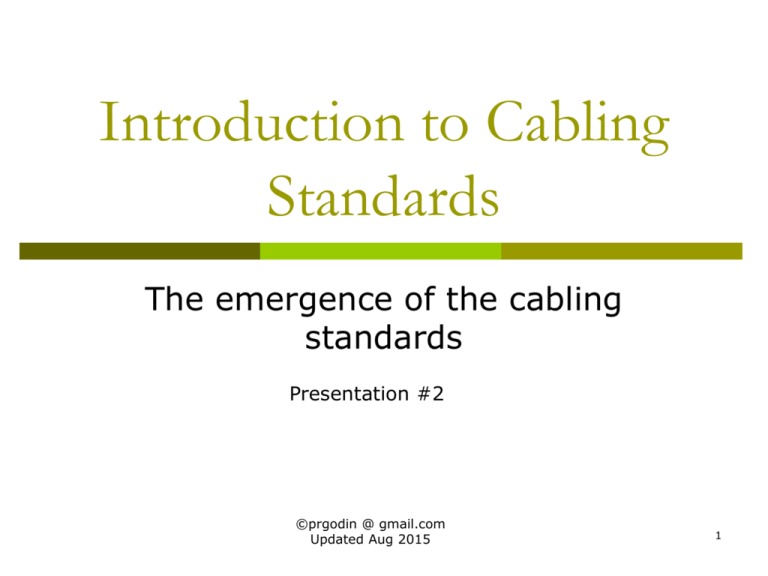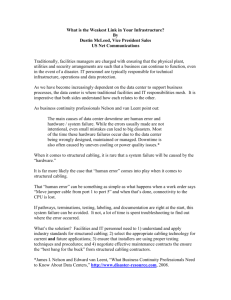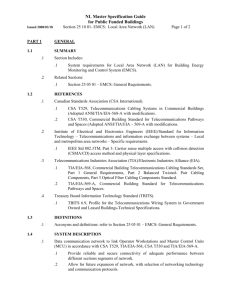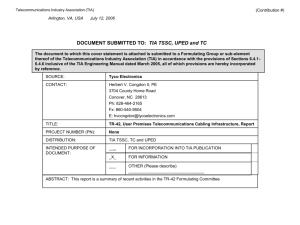Cabling Standards
advertisement

Introduction to Cabling Standards The emergence of the cabling standards Presentation #2 ©prgodin @ gmail.com Updated Aug 2015 1 How were the Structured Cabling Standards established? EMERGENCE OF STANDARDS 2 1837: Samuel Morse & 1st commercial telegraph in USA 1861: 1st coast-to-coast telegraph in USA 1866: 1st transatlantic telegraph 1876: A.G. Bell & first telephone 1878: 1st commercial telephone exchange 1904: 3 million telephones in the USA 1915: 1st coast-to-coast telephone in USA 1930’s: Electronic television is developed and commercialized 1947: 44 thousand televisions in the USA 1950: 10 million televisions in the USA 1956: 1st transatlantic telephone via cable (TAT-1), 36 channels 1963: 1st satellite-relayed telephone connection 1969: APRANET and first WAN network 1973: 1st cellular telephone call 1984: Longest voice fiber optic line in the world, 3268km, in Saskatchewan 1990: Elimination of party telephone lines in rural Saskatchewan 1981: IBM PC and MS-DOS introduced 1985: Ethernet standard 1991: Structured Cabling standards in America 1995: Internet commercialized and available to everyone For your reference only - not on any test Important Milestones in Telecom 3 The U.S. Communications Industry The telephone created a communications revolution. In 1900, AT&T and its Bell Subsidiaries were responsible for all telecommunications across the USA. They maintained a monopoly, although they eventually permitted smaller communication companies to hook up to their systems. Image: http://www.porticus.org 4 The U.S. Communications Industry In the late 60’s and the 70’s, companies such as MCI (Microwave Communications Inc) requested the courts for permission to create their own communication links and circumvent the AT&T monopoly. Main Reason: create competition in the new data communication market. 1984: Deregulation. 5 Telecommunications Standards The telecommunications industry deregulation began with the divestiture of AT&T, leading to the breakup of the Bell systems With no centralized guidance, the divestiture caused mass confusion and problems for customers, manufacturers, long distance carriers and service providers After deregulation, anyone could design, install and maintain telephone systems Computer technology was quickly maturing and growing and more organizations needed communication links Image: http://medicalconnectivity.com What standards are we following? Who sets these standards? 6 Prior to De-Regulation The telecom industry used to be heavily regulated by governments but government did not want to get directly involved in setting technical standards Telcos (TELephone COmpanies) set their own standards and system practices AT&TSPs-BSPs-NTPs Users and other companies had almost no say TSP=Telecommunications Service Priority (service related requests) BSP=Bell System Practice (documented practices) NTP=Notice to Proceed (documented procedure) 7 After De-Regulation Governments have limited regulatory say: Regulate the use of transmission frequencies Auction transmission frequencies Act as mediators but maintain competitive environment Any company can offer telecom services Large telecom R&D agencies associated with governments had to become commercial. Non-government means of establishing communication standards and acceptable practices needed to be found. 8 Canadian Cabling Practices In Canada any company could install computer communication cabling within premises but the telephone companies held the monopoly on voice cabling. Customers and installation companies wanted the ability to install both the voice and data communication cabling. Telcos brought legal action against companies that used computer cabling for voice communications. Results of the court cases? Deregulation! 9 Canada’s Deregulation Although not as far sweeping as the US, Canadian deregulation ended the monopolistic practices of the telecom companies and permitted other companies to participate competitively in the market. Deregulation was accomplished in stages: 1992: CRTC approves competition in residential markets 1994: Decision 94-19 allows all communication companies to provide all services 1997: Customers are free to choose their service providers 10 Review The US Telecommunications structure used to be mostly monopolized by AT&T and in Canada the Telcos were protected, but both countries deregulated and the protected monopolies ceased to exist. AT&T used to set all the standards for telecommunications but with deregulation and no central body some confusion resulted. The governments did not establish regulatory bodies for cabling structure and left it to industry to determine their course of action. 11 Optional Further Reading & Links Search for Colbert explaining the confusing name changes with AT&T companies. http://www.porticus.org/bell/att_divestiture.html explains the AT&T Divestiture in detail. http://www.youtube.com/watch?v=yoYq6uA_Lhw Direct Dialing and computer systems at Southwestern Bell in 1959. High tech, considering the microprocessor is 20 years into the future. 12 The Data Perspective The late 70’s to the mid 80’s were considered the age of mainframe systems, and saw the beginning of PC-based networks in industry. Mainframe systems consist of “dumb” terminals connected to a central processing system. Expensive, only larger organizations could afford them. 13 Mainframe and PC-Based Cabling By the late 80’s each system had its own vendorspecific software, its own cabling type and its own structure. 14 Mainframe and PC-Based Cabling IBM 3270: RG62 Coax & BNC connector (star) IBM System 3X: Twinax Cabling (daisy-chain) IBM: STP Token Ring (ring) http://www.connectworld.net http://www.cs.csustan.edu http://tech.mattmillman.com Mainframe and PC-Based Cabling DEC: Shielded Locap (“RS232”) cabling (star) Apple & Arcnet: RG58a/u or RG62u coax (mod star) http://www.connectworld.net http://www.cs.csustan.edu http://tech.mattmillman.com Mainframe and PC-Based Cabling IBM-PC: Thicknet & Thinnet Coax (bus) WANG: RG59 Twinned Coax (tree) …and there were more http://www.connectworld.net http://www.cs.csustan.edu http://tech.mattmillman.com Mainframe and PC-Based Cabling A software change often created a hardware change which required a cabling change. Cable vendors and installers were happy 18 Standards Without standards in place, each manufacturer of computing equipment set their own cabling structure and requirements. Customers were frustrated with having to recable their facilities whenever a system was changed. This was both expensive and disruptive. Users looked for a solution to this problem. Some vendors came up with a solution. 19 The Balun A basic device called a Balun (BALanced-UNbalanced) impacted the direction of vendor-specific cabling. This simple device, essentially an electronics transformer, converts between a basic telephone cable, called UTP (Unshielded Twisted Pair, balanced) and a Coax (unbalanced). A Variety of Baluns Image: http://www.trovacomputer.it 20 The Balun First offered as a “gimmick” in the late 80’s it was an effective solution to high re-cabling costs and gradually became an accepted option for some companies. The balun allowed a premise to install inexpensive UTP (telephone) cable and use appropriate baluns on each end to emulate the system-specific cable required. Changing systems no longer required a change of cable...only the baluns needed to be swapped. Voice-grade paired cable was also very small and inexpensive. 21 The Balun’s Impact In the mid 1980’s Synoptics* was the first company to offer an Ethernet** hub that allowed a direct connection for UTP cable without external baluns using the RJ45 (8 position) modular plug. An additional benefit of hubs was a far more universal structure to cabling. All cables were run from the workstation/PC to a central closet area (“Star” structure). * Synoptics became Bay Networks, purchased by Nortel Networks in 1998, purchase by Avaya in 2009 ** Originally called Lattisnet 22 The Balun’s Impact The idea of using UTP for data communications caught on. Companies began offering UTP Network Interface Cards (NICs) and hubs, and expanded the idea of UTP hubs to other data network types. External baluns became internal, and structured cabling using UTP became more universal. Eventually standards were developed for Ethernet, Token Ring and other communication protocols over UTP. 23 The Impact of the Balun There was no standard for the signal-carrying quality of the twisted pair cabling. For a time, the data rates were low (in kbps), but data rates improved and increased. Several cable manufacturers saw an opportunity and began offering better quality UTP cable to customers for data communications applications. In the late 80’s a large cable distributor, Anixter, established and promoted a “Levels” program to categorize the various performance “Grades” of UTP. It was a successful marketing tool but it was both proprietary and vendor-specific. Other companies pressed for a non-vendor specific standard for data-grade cabling that everyone could follow. Industry 24 turned to standards-setting bodies for help. Standardization Bodies The leaders in the development of structured cabling standards include: The Telecommunications Industry Association (TIA) North America’s standards body for structured cabling The International Organization for Standardization (ISO) a collection of standards organizations that represent 130 countries. Its goal is to establish international technological standards that facilitate the global exchange of information Important Slide 25 Standardization Bodies TIA and ISO committees work hand-in-hand to ensure the new grades of cabling support the latest innovations in signal transmission technology While the technical requirements of the TIA and ISO are similar for various grades of cabling, the terminology for the level of performance within each committee’s Standards can be confusing Both TIA and ISO state the cabling systems specified in their Standards should have a useful life in excess of 10 years 26 Other Standardization Bodies ANSI- American National Standards Institute CSA – Canadian Standards Association CENELEC – European Committee for Electro technical Standardization. ITU - International Telecommunications Union JSA/JSI- Japanese Standards Association 27 Other Standardization Bodies IEEE - Institute of Electrical and Electronics Engineers sets standards for the electronics and computer industries EIA – Electronics Industry Alliance made up of electronics manufacturers sets standards and helps write ANSI standards 28 Standardization Computer communication standards were nonexistent until 1985 when the CCIA (Computer Communications Industry Association) approached the EIA about developing them, resulting in the formation of the TR-41 committee In 1991, TR-41 split in two: TR-41 - responsible for User Premise Equipment standards, TR-42 - responsible for User Premise Telecommunications Cabling Infrastructure standards Ensuring that the standards remained an open system in support of voice, data, video, building control and other low level voltage, power limited applications 29 The Path to Standards AT&T set the technical, administrative and performance standards for its infrastructure. With AT&T’s breakup, vast infrastructure and a government that was unwilling to interfere with the market, the industry fixed itself. AT&T set the path to many of today’s communications standards. Computer and data communications standards were established by market forces, driven by: customer want & needs desire of manufactures to satisfy their customers requirement that products can connect to existing infrastructure and other equipment, including competitors 30 The Advantage of Standards Standards are independent The users will only accept standards-based products Vendors compete on an even level Standards advantages Ease of design, installation and maintenance Performance guidelines and baseline requirements Easier to train staff and provide moves/add/changes Increased lifespan of the installation Universally accepted Important Slide 31 Structured Cabling Standards Standards are specifications that guarantee a minimum level of performance and are used to quantify and qualify materials and components The assurance of the applications operation Cable and connectivity are backwards compatible Interoperable (vendor independent) Design and topology that is universal Managing of cable additions, upgrades, and changes Defines a cabling system that supports current applications and is a basis for future development 32 Advantages of a Structured Cabling System Consistency Support for multivendor hardware Easier additions, moves and changes Simplified troubleshooting Support for current and future applications Important Slide 33 ANSI/TIA/EIA Standards ANSI/TIA/EIA 568-C Commercial Building Telecommunications Cabling Standard = = = = Generic Telecommunications Cabling for Customer Premise Commercial Building Standards Balanced Twisted Pair Telecommunications Cabling and Component Standards Optical Fiber Cabling Components ANSI/TIA/EIA 569-C C.0 C.1 C.2 C.3 Commercial Building Standard for Telecommunications Pathways and Spaces ANSI/TIA/EIA 570-B Residential and Light Commercial Telecommunications Wiring Standard Important Slide 34 ANSI/TIA/EIA Standards ANSI/TIA/EIA 606-B ANSI/TIA/EIA 607-B The Administration Standard for the Telecommunications Infrastructure for Commercial Buildings Commercial Building Grounding and Bonding Requirements for Telecommunications ANSI/TIA/EIA 758 Customer-owned Outside Plant Telecommunications Standard (OSP) Important Slide 35 CSA Equivalent Standards CSA CSA CSA CSA CSA CSA T529 T530 T525 T528 T527 T758 = ANSI/TIA/EIA 568-B = ANSI/TIA/EIA 569 = ANSI/TIA/EIA 570 = ANSI/TIA/EIA 606 = ANSI/TIA/EIA 607 = ANSI/TIA/EIA 758 Note: The CSA has not published the latest standards. Several of the standards indicated above have been updated. 36 ANSI/TIA/EIA 568-C Commercial Building Telecommunications Cabling Standard Purpose Establish a generic telecommunications cabling standard that will support a multi-vendor environment Enable the planning and installation of a structured cabling system for commercial buildings Establish performance and technical criteria for various cabling system configurations 37 ANSI/TIA/EIA 568-C Standard The primary structured cabling standard Specifies Minimum requirements for telecommunications cable in an office environment Connector, cable types and performance requirements Recommended topology and distances Media parameters that determine performance Connector and pin assignment to ensure interconnectivity Important Slide 38 OTHER TIA/EIA STANDARDS 39 ANSI/TIA/EIA 569-C This standard defines design specifications and guidance for all building facilities and spaces relating to telecommunications cabling systems and components. This standard identifies and addresses six prominent components of the building infrastructure: 1. Building entrance facility 2. Equipment rooms 3. Backbone pathways 4. Telecommunications rooms 5. Horizontal Pathways 6. Work Areas Important Slide 40 ANSI/TIA/EIA 570-B Applies to telecommunications cabling systems pathways and spaces for single and multitenant buildings. This standard is primarily designed for residential applications of communication cabling. Applies to telecommunications cabling within and between structures such as cabling within the living space and backbone cabling Important Slide 41 ANSI/TIA/EIA 570-B Grades of Residential Cabling Grade 1 – provides a generic cabling system that meets the requirements for basic telecommunications services. Grade 2 - provides a generic cabling system that meets the requirements for basic, advanced, and multimedia telecommunications services Typical applications would consist of telephone, satellite, fax, modem and CATV services including cable modem and xDSL services 42 ANSI/TIA/EIA 606 The ANSI/TIA/EIA 606-A Standard specifies administration for a generic telecommunications cabling system in a multi-product, multi-vendor environment. It provides a uniform administration approach that is independent of applications, which may change several times throughout the life of the telecommunications infrastructure. It establishes guidelines for labeling, documenting and drawing of the structured cabling plant. Important Slide 43 ANSI/TIA/EIA 607-B Provides guidance around the issues of Bonding and Grounding as it relates to the telecommunications infrastructure Specifies a uniform telecommunications grounding and bonding infrastructure that shall be followed within commercial buildings Purpose is performance and safety Important Slide 44 ANSI/TIA/EIA 758 Provides requirements used in the design of telecommunication pathways and spaces, and the cabling installed between buildings or points in a customer owned campus environment. Specifies the minimum requirements for customer owned OSP (Outside Plant) telecommunications facilities in a campus environment Specifies the cabling, pathways, and space infrastructure. Important Slide 45 Codes In the US, the National Fire Protection Association (NFPA) maintains the National Electrical Code (NEC). The NEC specifies where various types of cables can be used within a building and the materials used in the cables. The two important Canadian codes are: National Fire Code of Canada (NFCC) Canadian Electrical Code (CEC) CSA- C22.1-06 Important Slide 46 Standards vs Codes The TIA/EIA standards are optional whereas the Codes are legal requirements. Certain aspects and areas of a data communication installation must be carried out by certified personnel such as an electrician. This includes building grounds, electrical systems and may include installation of conduit. All fire regulations must be followed. For instance, the cable must meet certain standards for combustion. Important Slide 47 Other Regulations Additional regulations include those related to workplace safety and training, security clearance for access to sensitive areas of a building and other municipal, provincial or federal government regulations. Some clients may have additional rules, regulations or policies to follow. 48 Review Questions What is the difference between a standard and a code? What are the main structured cabling standards (number and title)? 49 This section is FYI (For Your Information) only, but know the terminology in the text boxes. ESTABLISHING STANDARDS 50 Interconnection and Standards Everything in telecommunications may appear to be easy if one thinks of only one dominant manufacturer or carrier with proprietary systems. However the essence of telecommunications is several carriers or manufacturers working together to provide a set of commonly understood products or services. Internally the devices and systems may all behave differently but externally, they must behave in the same “standard” way They have to interact with related services or devices and require common protocols Proprietary = is owned, patented or copyrighted by a company, only that company does it 51 A Standards-Compliant Device or System Standard Interface Implementation may be proprietary Interface Interface 52 How Standard Bodies Work (there are a variety of procedures) Consensus process Voluntary process, driven by government regulators and industries Typical operation (ISO, ITU): Member bodies are countries, companies or standards councils (example: Standards Council of Canada http://www.scc.ca/) Participants are interested individuals (the experts), often delegated by companies, companies or councils. Member bodies propose Work Items (something that needs to be standardized) Work items are approved by international ballot A committee is formed made of interested experts 53 Typical operation (ISO, ITU) (Continued . . .) The committee meets many times and works on progressively more complete working drafts Each draft is submitted for ballot to member bodies. Each body decides on the vote (yes, no, abstain). Votes include technical comments for enhancements, etc. The final approved document is called a standard or recommendation. Standard and recommendations are then maintained and periodically enhanced by appropriate committees, again each change must be discussed and approved. 54 What standards are based on Some standards simply document pre-existing industrial practices, regulations, or ‘de facto’ standards however these are usually modified during the standardization process to: Make them more complete Be more universal Be flexible for future development Be more consistent Not give an advantage to any particular company or group Provide options where different practices may exist De facto: Latin term used to describe a fact or actual practice. Example: a “de facto standard” is not a official standard, but a standard practice that everyone adopts or traditionally does. 55 Who participates in the process Participants vary according to the type of standard and of standard organization. In the past, ISO and ANSI standards were mostly driven by industrial concerns CCITT/ITU standards were mostly driven by government regulatory bodies in telecom in Europe, the PTTs (Post, Telephone, Telegraph ministries) in NA, large companies having monopoly on some areas In Canada, CRTC reporting to Parliament through the Ministry of Canadian Heritage Other standard bodies are organized by professional associations, for example electrical engineers in the case of the IEEE. De-regulation has allowed the users a greater voice in standards implementation. 56 Current Situation Companies work hard to provide increasingly complex systems at lower costs. Users shift allegiances quickly to find companies that offer more for less. There are lots of different standards, and variations of standards. High quality of telecom services was expected in the past situation of strict government regulation and monopoly. This quality may decline in the short run, to test how bad (and inexpensive) it can get before customers stop buying a product. De facto standards may become dominant, and may eventually become de jure standards. De Jure: legally or law. A de jure standard is one that is established and documented. 57 Evolution of Network Architectures In widely distributed telecom systems, new standards may be implemented only in certain parts of the system (for instance, in new installations). New standards have to be written in consideration of the fact that they will have to interact with the old standard (backward compatibility). New standards have to include some support of the old, grandfathered elements. Backward compatibility: Allowance in a system for operation with older equipment. Grandfathered: Element of a standard that is no longer supported for new installations but is still acceptable for older installations. 58 The Structured Cabling Standards Standards are written in a manner that satisfies the requirements of all those involved including the manufacturers, installers, support staff and users. Detailed technical specifications for manufacturers General specifications and methodologies for installers and support staff Basic processes for the users The standards themselves often contain technical issues that are of little or no concern to the end user. 59 Standards and Implementation Standard are constantly changing to include new technology. This means that end users, designers and installers need to keep up with standards. In the last 15 years, there have been at least 7 generations of UTP cabling, and many users are used to upgrading cabling and network hardware regularly. 60 Resources ANSI/TIA/EIA Standards – available in the classroom as well as on-line Anixter Standards Reference Guide www.anixter.com ITU Standards http://www.itu.int/en/Pages/default.aspx Most vendors in the industry offer technical reference information 61 CERTIFICATION & INDUSTRY 62 I Can Install That The communication cable installation industry is not a “Trade” like electricians. It isn’t regulated so anybody can install communication cabling and claim expertise. Industry has come up with training and certification systems to demonstrate a level of proficiency. This course demonstrates knowledge and experience (mention this course in your resume). 63 BICSI Building Industry Consulting Services International Non-profit organization that provides industry-recognized accreditation. BICSI also organizes conferences and forums, provides publications and supports training. https://www.bicsi.org/ 64 BICSI Certification RCDD: Registered Communications Distribution Designer RCDD/LAN Specialist Installer: Level 1 Level 2 Technician Exams and proof of industry participation required. There are requirements for maintaining and for improving certification status…it’s not a one-time effort. Expensive and somewhat time-consuming, certification is for those that are dedicated to the industry. 65 Manufacturer Certification Programs Manufacturers of Structured Cabling offer certification training for installers The installation company needs to be certified to install their products and offer warranties. Staff need individual certification. Certification is only valid while employed with a certified installation company. 66 www.leviton.com Manufacturer Certification Programs There are benefits to manufacturer certification programs: The installers get client support from the manufacturer (technical, training, marketing, sales, etc). The manufacturer has installers that provide sound installations and sell their products. The customers will receive a guarantee of workmanship and performance directly from the manufacturer. 67 Review Questions What is the difference between a de jure and a de facto standard? Is a grandfathered element of a standard still supported? Explain. What is a balun? What is the difference between a code and a standard in communication cabling? Name an example of each. End of Presentation prgodin @ gmail.com 68




